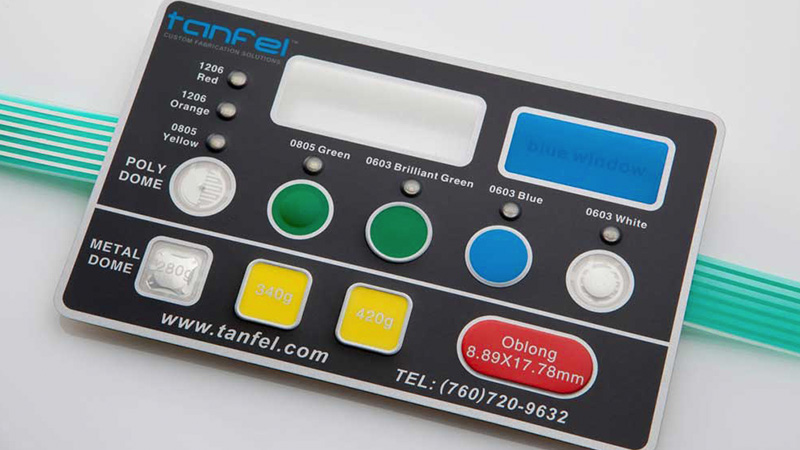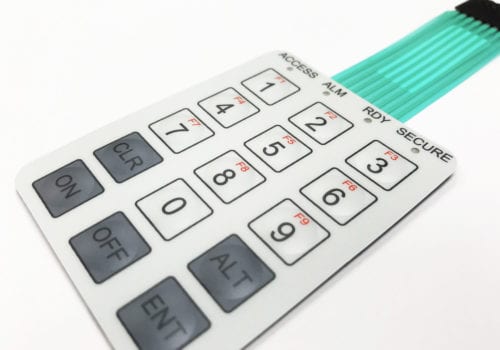How Membrane Switches Are Used to Improve Safety and Functionality in Machinery
How Membrane Switches Are Used to Improve Safety and Functionality in Machinery
Blog Article
Membrane Layer Change Modern Technology: The Secret to Trusted and Cost-efficient Interfaces
Membrane layer button modern technology has arised as a pivotal component in the layout of customer interfaces, supplying both reliability and cost-effectiveness throughout a varied range of applications. As we discover the multifaceted benefits of membrane layer switches, their capacity for innovation raises inquiries concerning future applications and progressing patterns.
Comprehending Membrane Switch Modern Technology
Membrane layer button technology is a widely utilized interface remedy in different electronic devices, providing a smooth blend of performance and style. This modern technology integrates several layers of products, normally containing a graphic overlay, spacer layer, and a circuit layer. The visuals overlay shows the user interface components, while the spacer layer divides the circuit layer from the overlay till a user activates a switch.
When pressure is used to the overlay, the circuit layer completes the electric circuit, sending a signal to the device. This system permits for numerous arrangements, consisting of responsive responses and backlighting alternatives, improving customer interaction. Membrane layer switches are generally produced making use of durable materials such as polyester or polycarbonate, making sure durability and resistance to ecological aspects like wetness and dust.
The versatility of membrane layer changes enables their application in varied industries, including medical tools, consumer electronic devices, and industrial controls. Their portable layout enables combination right into space-constrained settings, providing an efficient interface without endangering aesthetic allure. Understanding the details of membrane layer switch technology is essential for suppliers and developers looking for to produce dependable and reliable human-machine user interfaces.
Secret Advantages of Membrane Buttons
While different interface remedies exist, membrane switches over deal distinctive benefits that make them a preferred selection in various applications. One of the main advantages is their longevity; membrane switches are developed to withstand severe environmental problems, including moisture, dust, and temperature variations, ensuring durable efficiency. This durability substantially minimizes the demand for frequent substitutes, consequently reducing overall maintenance expenses.

Additionally, membrane buttons are lightweight and portable, making them appropriate for applications where room is limited. Their inconspicuous layout adds to a sleek appearance without endangering functionality.
Cost-effectiveness is additionally a notable benefit, as the production procedure for membrane switches often tends to be more economical compared to standard mechanical switches. This affordability, combined with their integrity and simplicity of setup, placements membrane layer changes as a practical solution for a variety of sectors looking for reliable and effective interface.
Applications Throughout Various Industries
How do membrane buttons adapt to the varied demands of different sectors? Membrane layer button innovation is increasingly identified for its flexibility, making it appropriate for a wide variety of applications across several sectors.
In consumer electronic devices, membrane layer buttons supply a portable option for push-button controls and home appliances, boosting user experience with instinctive style. Additionally, the industrial field Related Site leverages membrane layer switches for equipment control board, taking advantage of their resistance to rough environments, such as wetness and dust.
Military and aerospace applications also utilize membrane buttons for their reliability and capacity to stand up to severe problems, making sure functional efficiency in crucial situations. The food and beverage industry embraces these switches for automated systems, where hygiene and simplicity of operation are extremely important (membrane switch). Eventually, membrane layer switches are tailored to meet the one-of-a-kind demands of each sector, showing their vital function in modern helpful resources innovation interfaces
Style and Customization Alternatives

In the world of membrane button technology, layout and customization options play a pivotal function in improving functionality and customer interaction. These switches can be tailored to fulfill particular operational needs and visual choices, making them functional parts in various applications.
One of the key personalization options is the layout of the button itself, which can be designed to accommodate distinct interface and ergonomic considerations. By changing the shape, size, and setup of buttons, manufacturers can create intuitive layouts that help with ease of usage. Additionally, the unification of different colors and visuals overlays permits branding and enhanced visibility, making sure that customers can rapidly identify features.
Moreover, membrane buttons can be engineered with different tactile comments mechanisms, such as increased switches or audible clicks, to enhance the user experience. Different materials can likewise be picked for toughness and environmental resistance, attending to elements such as dampness, temperature variations, and chemical exposure.
Eventually, the substantial style and personalization choices readily available in membrane button innovation equip companies to develop tailored options that not just fulfill functional needs but likewise align with their branding and functional demands.

Future Fads in Membrane Buttons
As membrane layer switch technology continues to progress, future trends are significantly focused on improving user experience and incorporating sophisticated functionalities. One considerable pattern is the assimilation of touch-sensitive and capacitive modern technologies into typical membrane layer switches. This development enables even more user-friendly interface, offering tactile responses while preserving a sleek style.
One more arising pattern is making use of eco-friendly materials, driven by the expanding demand for sustainable production practices. Producers are looking for to minimize their carbon footprint by making use of recyclable substratums and low-impact inks, lining up with international sustainability objectives.
Moreover, the surge of the Web of Things (IoT) is triggering the consolidation of clever features right into membrane layer buttons. Improved connection alternatives will enable tools to interact with each various other, permitting seamless combination into broader systems.
Furthermore, advancements in printing modern technologies, such as electronic printing, are permitting for higher style versatility and personalization. This allows suppliers to create elaborate styles and vivid shades cost-effectively.

Conclusion
In visit final thought, membrane layer switch technology stands for an essential development in customer interface layout, providing substantial benefits in durability, customization, and cost-effectiveness. As innovations continue to arise, specifically in touch-sensitive user interfaces and lasting products, the potential for membrane switches to boost user experience and functionality remains promising.
Report this page